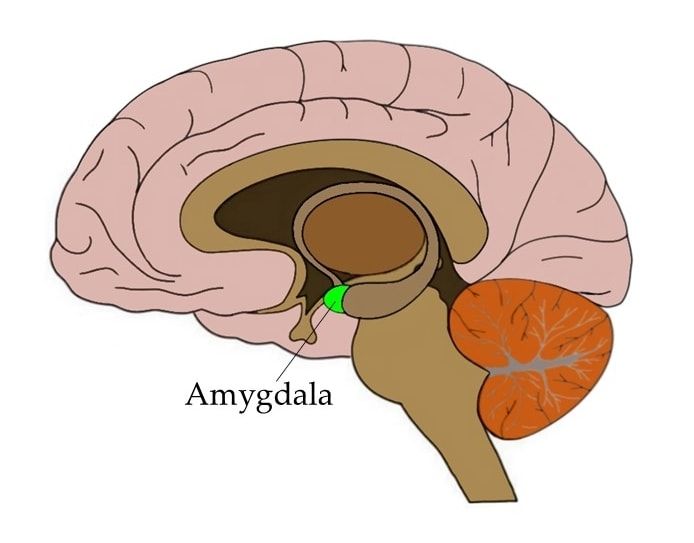CONTENTS:
INTRODUCTION
WHAT IS THE AMYGDALA
ANATOMY OF THE AMYGDALA
REGULATION OF EMOTION
FUNCTION OF THE AMYGDALA
DYSFUNCTION OF THE AMYGDALA
CONCLUSION
INTRODUCTION:
To appreciate the significance of emotions, just imagine life without them. Instead of the daily highs and lows we all experience, life would likely feel like a great empty plain of existence with little significance. Emotional experiences are a large part of being human. In books and movies, aliens and robots may look like people, but they usually seem inhuman simply because they exhibit no emotions. In this article we explore emotion.
WHAT IS THE AMYGDALA:

The amygdala is a region of the brain primarily associated with emotional processes. The amygdala is drive from the Greek word amygdale, meaning “almond”, owing to the structure’s almond like shape. Its part of a larger network in your brain called the limbic system. When it comes to your survival, your amygdala and limbic system are extremely important. These are part of your brain that automatically detect danger. They also play a role in behavior, emotional control and learning, the amygdala is located in the medial temporal lobe, just anterior to (in front of) the hippocampus. similar to the hippocampus, the amygdala is a paired structure, with one located in each hemisphere of the brain.
ANATOMY OF THE AMYGDALA:

The amygdala is situated in the pole of the temporal lobe, just below the cortex on the medial side. The human amygdala is a complex of nuclei that are commonly divided into three groups: the basolateral nuclei, the corticomedial nuclei, and the central nucleus. Afferents to the amygdala come from a large variety of sources, including the neocortex in all lobes in the brain as well as the hippocampal and cingulate gyri. Of particular interest here is the fact that information from all the sensory system feeds into the amygdala, particularly the basolateral nuclei. Each sensory system has a different projection pattern to the amygdala nuclei, and interconnection within the amygdala allows the integration of information from different sensory modalities. two major pathways connect the amygdala with the hypothalamus: the ventral amygdalofugal pathway and the stria terminalis.
REGULATION OF EMOTION:

Emotion responses to sensory stimuli not only arise through innate mechanisms and through learning but also can be altered by extinction and cognitive control mechanisms. Both extinction and cognitive control involve interactions between the prefrontal cortex and the amygdala. Extinction, which itself is a learning process, is induced by the repeated presentation of a conditioned stimulus in the absence of a previously associated unconditioned stimulus, resulting in the elimination of a previously elicited response. Projection from the prefrontal cortex to the amygdala mediate extinction, with complex circuitry involving the central nucleus, the basolateral complex, and the intercalated masses playing a role in the modification of responses to previously conditioned stimuli. the cognitive control of emotion is an important process to understand, giving its critical in normal adaptive emotional behavior.
FUNCTION OF THE AMYGDALA:

the amygdala plays a prominent role in mediating many aspects of emotional learning and behavior. There exist a vast array of human emotions, ranging from joy to sadness, disgust to excitement, and regret to satisfaction. Most emotions possess a valance (positive or negative) and an intensity (low to high) that reflects emotional arousal. Studies of the neural basis of emotion in animal models, including those focusing on the amygdala, typically have utilized physiological (e.g autonomic) or behavioral (e.g approach or defense) measures that likely reflect the valence and intensity of an emotional experience.
In the early part of the 20th century, psychologist Heinrich kluver and neurosurgeon Paul c. Bucy studied monkeys with lesions of the temporal lobe that included the amygdala and observe changes in emotion, feeding and sexual behavior. Subsequent studies established that the amygdala was a critical structure mediating those effects.
DYSFUNCTION OF THE AMYGDALA:

Problems in how the amygdala works and how it connects with other parts of the brain, like the prefrontal cortex, are believed to play a role in many mental health disorders. These connections, which are important for managing emotions, don’t fully develop until early adulthood. Many neuropsychiatric disorders like addiction, anxiety, and autism, often appear before or during this period.
In autism, for example, difficulties with social interactions, emotion and thinking may be linked to how the amygdala functions. Research in humans and animals suggest that issues in the brain circuit may explain this disorders. As scientist learn more, they hope to identify the brain mechanisms involved and develop better treatments to help people with this condition.
CONCLUSION:
In summary, the amygdala is a vital brain structure deeply involved in regulating emotions, influencing behavior, and maintaining social and cognitive functions. Its intricate anatomy and connections with other brain regions, enable it play a central role in emotional processing and responses. while its functions are essential for adaptive behaviors, dysfunctions within the amygdala and its neural circuits can contribute to various neuropsychiatric disorders.
Understanding the amygdala’s roles, and potential for dysfunction not only shed light onto the complex interplay between brain and behavior but also opens the door to new therapeutic approaches. As research advances, uncovering the precise mechanisms of amygdala dysfunction could revolutionize our ability to treat and manage these challenging condition, enhancing the quality of life for individuals affected by them.
